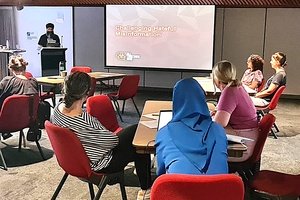In this special series, we chart one secondary teacher’s journey back from rock bottom, sharing the strategies, insights and knowledge she’s gained as she took back control of her mental health and regained a sense of fulfilment in the classroom. Here’s Part 2...
Burnout survivor Sue Webb believes there’s a cut-through analogy that can help teachers experiencing the condition to chart a path forward in their recovery.
Based on the work of Nick Petrie, a leadership researcher and expert on how to beat burnout in the workplace, Webb says it pays to assess your state of wellbeing as you would an actual burn to the flesh.
“[Petrie] talks about first-degree, second-degree and third-degree burnout based on his research, and I think it’s a really, really helpful analogy.
“Because if we think about a first-degree burn, which is a surface layer burn, and that’s uncomfortable, but it can be easily treated by taking a cool bath and putting aloe vera on it – and you can recover within a week or maybe even a few days.
“But if you’ve got a third-degree burn, which is a deep burn, often down to the bone, then if you try and apply those same remedies, a) they won’t be helpful, and, b) it might even cause more damage. And it’s the same with burnout.”
Teachers who are quick to intervene at the early signs of first-degree burnout are effectively able to self-manage their way out of anything more serious, Webb says.
This can be done by drawing more heavily on those tried and tested self-care strategies, such as exercise, focusing on quality food and bedding down adequate sleep, she adds.
“Most people can continue working, they might need a day off here or there, but generally speaking, they can continue to work through that.
“But if people are experiencing third-degree burnout, the recovery time is a lot longer.
“And self-care strategies like staying hydrated and exercising is not enough.
“Third-degree burnout usually needs a period away from work and higher-level interventions, which include the help of a medical professional.”
Taking recovery into her own hands
Suffering from crippling OCD, paranoias and extreme anxiety at the height of her illness in 2019, Webb’s burnout had progressed so severely she was forced to take a year off teaching and work altogether.
“In the end, I couldn’t hold on anymore,” she says.
Distressed but plagued by questions about how it had got to this point, Webb began to sift through the growing evidence base while seeking professional mental health support.
Despite feeling exhaustion deep in her bones, she hadn’t yet equated her symptoms as the product of chronic workplace stress.
The tell-tale panic attack some years before had occurred on a motorway and not at school, for one.
“It really wasn’t until I did a deep dive into what was going on for me, and I did a lot of reading about the causes and the symptoms of burnout, how to prevent it, how to manage the risk factors, what interventions we can use, (that I acknowledged I had it).
“I guess it’s the [saying], ‘once you know better, you can do better’. Once I understood better, I started to change the way I worked.
“For starters, I started journaling, and that’s actually what lead to the book [Teachers Cry Too], because I really needed to answer two questions for myself: What happened? And why did it happen?” Webb reflects.

English teacher Sue Webb says those who don’t change the stress factors in their jobs will notice burnout symptoms reemerge mere weeks after resuming work at school.
Making changes at work
When she did return to teaching, Webb came armed with a plan and a priority list.
Teachers who don’t actively change the stress factors in their jobs will notice their burnout symptoms reemerge mere weeks after resuming work at school, she is keen to warn.
“I made very clear time boundaries and energy boundaries … which meant I decided when I clocked off and when I clocked on. I really stuck to that and I made it a habit.
“I also got better at switching off from ‘work mode’ after school. And I did that by creating little routines for myself.”
Known as ‘psychological bookmarks’, Webb found that seemingly insignificant habits sent a powerful signal that it was safe to relax.
“It might be you change into your favourite pair of track pants, or a really comfortable oversized shirt, or it might be you light a candle when you get home or you put some music on.
“Often as teachers, we bring our work home with us. I could feel that wasn’t good or healthy for me. So, I needed to find ways to stop doing that. And those little routines really worked,” Webb says.
Meanwhile, the educator got clear on exactly what it was she loved about teaching.
And upon resuming work, she made it her mission to prioritise the thing she found most energising and which reconnected her to the joy of the job: the time and energy to be with students in the classroom.
“Anything that fed into that I said yes to, anything that didn't, I said no to.
“This happens often in schools, they might say, ‘Oh, we’re really short staffed on the Year 10 camp, could you go on that?
“Well, actually, I’m not saying no forever, but this year my priority is my teaching and learning and the quality of my classroom.
“The Year 10 camp, although it’s really valuable experience, it doesn’t align with those priorities that I’ve set for myself…” Webb models.
She found school leadership were generally supportive of the stated boundaries when she explained the reason behind them.
“This is where I think communication is really important,” she begins.
“One of the things that was crucial for me when I was sick, was getting enough sleep.
“And when you’re sleep deprived, everything is so much worse. I knew that for my own health and wellbeing and my ability and my capacity to do the job, I needed to prioritise my sleep.
“If I go away on a three-day school camp, where you’re on 24/7 and you might get four hours sleep – if you’re lucky – I just couldn’t do that it.
“It would not have been fair to me or anybody else to put myself in that position.
“And by being open and honest about that, with your supervisor or your line manager, I found nobody ever had a performance conversation with me, let’s put it that way,” Webb shares.
Since recovering, Webb has been able to once again attend (and enjoy) school camps.
“Did I get pushback? No, because I think people could see that ‘this is out of character for Sue’.
“And people are very understanding and supportive of when you when you’re honest with them and open with them about what you need.”
Having the hard conversations
Teachers suffering from burnout, regardless of its stage, might understandably feel hesitant about discussing it with leadership.
Fears over appearing incompetent or unworthy of future promotions are well founded, Webb says, and it can be risky and ultimately problematic to disclose mental health problems to somebody you don’t trust.
“I think it takes some great courage to go to anybody, actually, to disclose the difficulties you’re having with your mental health,” she says.
“Partly because when you’re in a point of crisis, it’s very difficult to articulate your needs clearly. You find it hard to know what you need yourself,” Webb says.
Brain fog only clouds the scene for many teachers who try and advocate for themselves with employers, she notes.
“But having said that, I’m quite optimistic that schools are learning to do things differently.
“As we learn more about wellbeing and what it really means, we can respond in a way that is more effective and more supportive of people who need the help.”
Don’t miss Part 3 of our series on teacher burnout next week, when we dive into the third chapter of Webb’s journey and highlight the impact her book on burnout has had on teachers across the country and beyond.
Webb’s Instagram page @teacherscrytoo offers a place of support and advocacy for teacher wellbeing. Her book, Teachers Cry Too, was published in 2022. She also works with schools and teacher training organisations to help teachers recognise the symptoms of burnout and to develop intervention strategies to minimise the risk factors. Webb also facilitates teacher wellbeing and induction programs designed for early career teachers. You can find out more by emailing suewebbpd@gmail.com














